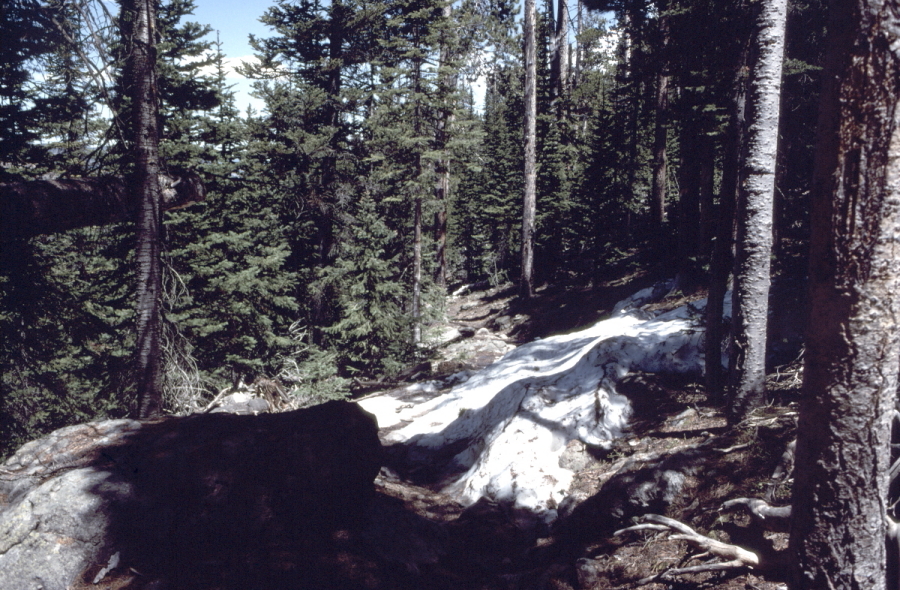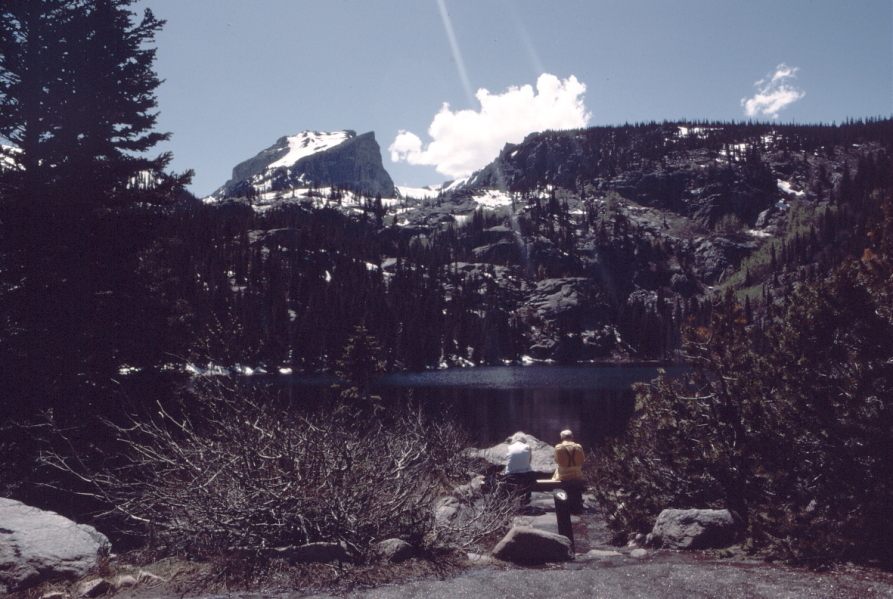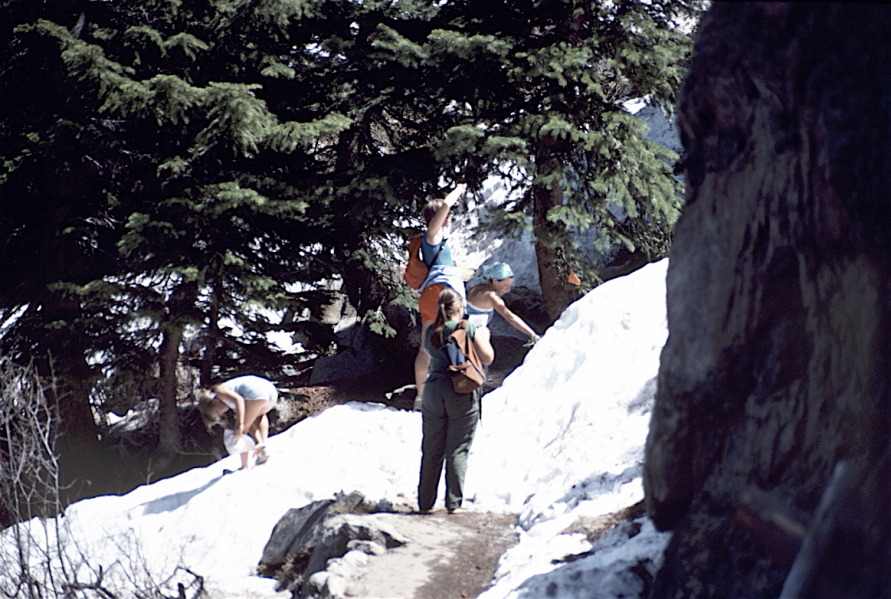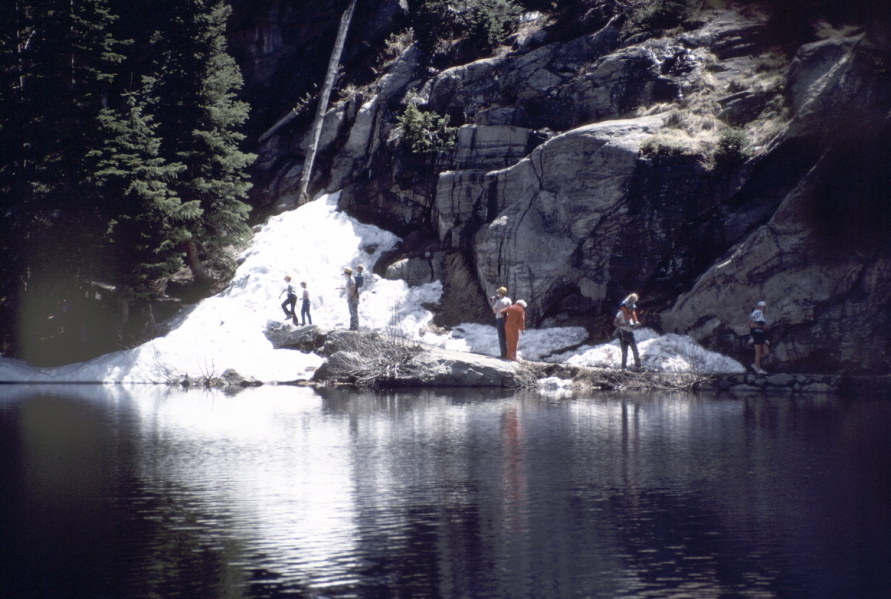Monday 20th June
Camping last night wasn't as bad as I'd feared it might be. The woollen socks had kept my feet lovely and warm.
Early morning and now the sun is blazing down and if anything I'm rather too hot. I'm still feeling homesick and think a day on my own may be better an a day with Stewart, who isn't Andy! I explain to him how I feel and he says that he had noticed. Now we have started talking I broach a few more subjects which I perceive to be causing friction between us but he doesn't reply. It crosses my mind again that I may be being rather selfish. To be fair he didn't force me to travel with him, he hasn't done anything other than be friendly and he must be thinking he could have chosen a more amenable holiday companion.
We have one map and decent water bottle between us. We were given the map at the entrance to the park. It's my idea to separate so we agree that Stewart should take them and I will find myself replacements. I set off for the nearest visitors centre and walk for almost two miles before arriving. When I look at the map I realise I took a very circuitous route. Ah well. I've got the map now but no water bottle.
I set off walking towards Bear Lake, my chosen destination. I still don't have any water and I have very little food - only a couple of apricots - and am a little worried but somehow feel stubbornly reckless. What am I trying to prove? Some sort of endurance? That I can explore more of the park, cover more miles, than Stewart? Probably. I put to the back of my mind that his slower pace, which I criticised earlier and gave as one of my excuses for walking alone, probably means he is experiencing more of the park's attractions than I am; that his patience might mean he spots more of the flora and fauna, that he will be almost certainly be getting better photographs than I do.
My route takes me about 8, maybe 9 miles following the trails up and over the moraines and ridges and the lower, smaller peaks. To go into the real wilds and the higher peaks requires a permit and more time, experience and equipment than I have. I stick to the well marked, well trodden routes. I try to slow down, to stop, to look around, to stand quietly and enjoy the scenery. I take a lot of photographs without much confidence that they will reflect the scale or grandeur of the scene before my eyes.
I eat my two apricots well before I arrive at Bear Lake. I meet two rangers who tell me that the weather is too hot for most of the animals and I would do better looking for them in the evening at dusk. A little later I walk for a way with someone who had been camping at one of the backpack camping grounds and he tells me he saw an elk and a couple of coyotes but that it was much earlier in the morning, before the sun was high.
My walk is mainly up and I notice that my quad muscles are starting to ache. I'd noticed it last night after my rather short run but I am determined not to let it put me off. My main problem is thirst. It is nearly three hours since I last drank and I am determined to get to Bear Lake so I decide I will drink from the next stream. The water is very clear and cold. I only manage to drink a few hands-full, but for now it quenches my thirst.
I continue to go up and up, there is snow on the trail. At first they are small drifts and no obstacle but it is strange to feel so hot, under such a blazing sun and yet be negotiating snow drifts. I am not a skier and I have never been on a winter sun and snow holiday. The white snow, the brilliant sunshine, the deep blue sky and the quietness instil a sense of calm. It hits me that the world is beautiful and I shouldn't be rushing through it. I may not get the chance to see this again so I should stop to take it in, experience it.

The drifts gradually become larger and deeper. I can no longer skirt round them but have to wade through them. It crosses my mind how ill prepared I am. What if the weather changes? It must be very cold up here, especially at night. But for now the snow is an answer to my lack of water. I break off a chunk of the cleaner looking icy snow and eat it like a lollipop. It is very cold but wet in my very dry mouth and more importantly provides essential hydration. I continue to make snow lollies from the drifts until I think I have taken in enough water.
I arrive at Bear Lake and my first priority is to find something to drink and then to check how I can get back to Moraine Park. The tourist information map shows a bus service. I ask one of the wardens where I can find the bus stop and what time the buses run and he tells me they didn't start until Wednesday! Several people overhear my conversation and offer me a lift but I haven't yet walked around the lake, a main reason for me choosing this destination, so I thank them and decline. The ranger advises me that there is a bus from Glacier Basin back to Moraine Park campground and that I could take the road which is approximately five miles.

I walk around the lake slowly, stopping often to look out for the birds and photograph the chipmunks that are prepared to stand and pose long enough for a slow photographer like me to get the shot. I see many magnificent blue birds. I don't know what type they are and they move too fast for me to photograph although I try. The trail is busy. This is a popular destination.

On the far side of the lake the trail is blocked by snow and a number of children are trying to scramble across. They are enjoying themselves struggling in the snow. I meet a young man from New York, Long Island and get talking to him. We walk together along the road from Bear Lake to Glacier Basin, chatting about holidays, places we have visited, this and that. The time goes more quickly and it doesn't seem long before we arrive at Glacier Basin.
According to the map, at least my interpretation, the bus departs from a parking lot opposite the campground. We walk around the site but are unable to find the bus stop and decide to continue our walk to the next stop a couple of miles further down the road. As we walk we see deer grazing. Apart from the chipmunks these are the only animals I've seen close up so I decide it was lucky we hadn't found the bus stop at Glacier Basin.
The bus heading to Glacier Basin approaches us and stops. We get on and ride back to Glacier Basin before being taken back to our campsite at Moraine Park. After walking all day I am relieved to be on the bus heading back to my tent.
Stewart is not at the tent. He arrives about an hour later. I am feeling better now and we chat about our walks. Stewart has enjoyed his day. He didn't walk as far or go so high as I did but he walked a long way. He had been able to relax and take his time over his photographs without feeling pressure from me to keep moving, now he drops down by the tent to rest. I write another post card to Andy and read my novel. It is a pleasant setting; I can hear birds chirping and smell the woodsmoke from the camp fires which are starting to light up the campsite. The moon is clear in a deep blue sky even though it is not yet dark. I stop concentrating on the novel and find my thoughts wandering back over the day.
I hadn't seen many animals but I'd noticed lots of leafy lichens, which I've heard is a sign of clean air. I wonder what impact the cars and motorbikes have on the environment. Even here in the park there are a lot of cars, most of them large. They make our hired Toyota Corolla seem very small. Why do Americans have such big, gas guzzlers? Large cars for a large landscape? Large cars for large people? To my European eye they are ungainly and inelegant, but they are certainly part of the American experience as are the motorbikes.
The motor bikes! I've never seen any like them before except in films. Front wheels on extended forks at about 120o to the horizontal armchair like reclining seats and raised handlebars. To me they don't look stable, safe or comfortable to ride for long periods, but I assume they must be as they are so popular - and surely the Americans have vehicle safety laws, although judging by some of the "jacked up vehicles" on extremely large wheels, they must be different from ours. I wonder whether the raised vehicles are to cope with off road terrain or flash flood conditions or are they just fashionable like the motorbikes? Do they really need such high clearance?
There are "ordinary" motorbikes too but they all look large and powerful, no 250cc engines in this part of the world, but then many are heavily laden and (or) towing trailers. A different way of life; a different scale, a different pace, a different climate. To experience and wonder at these differences is what makes travelling interesting. Everything seems to be in extremes. There doesn't seem to be any middle ground. Take the motorbike riders: I estimate that about half of them were huge, overweight and carrying their spare tires around their own middles and the other half were tanned demi-god types who could easily feature on fashion magazine covers. Very few wear safety helmets and most wear very few clothers. How they protect themselves from the sun or the windchill of riding at speed I can't imagine - maybe they don't. Maybe they are just tough.
